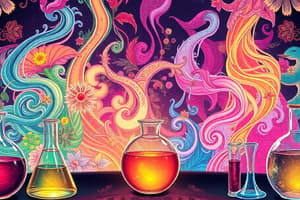Podcast
Questions and Answers
What are the common observations that a chemical change has occurred?
What are the common observations that a chemical change has occurred?
Evolution of gas, change in color, change in odor, formation of precipitate, or evolution in heat and light.
List the materials used in this experiment.
List the materials used in this experiment.
1.0M Copper(II) nitrate, 1.5M Sodium hydroxide, 1.5M Hydrochloric acid, and 5cm of aluminum foil.
What is the first procedure in this lab?
What is the first procedure in this lab?
In the 250ml beaker, make a water bath by heating up until boiling approximately 100ml of water.
What is done in procedure two?
What is done in procedure two?
What should be added to the first mark in procedure three?
What should be added to the first mark in procedure three?
What does procedure four involve?
What does procedure four involve?
What is observed in the fourth procedure?
What is observed in the fourth procedure?
What should be done in procedure five?
What should be done in procedure five?
What observation is made during the fifth procedure?
What observation is made during the fifth procedure?
What is the action in procedure six?
What is the action in procedure six?
What is observed in the sixth procedure?
What is observed in the sixth procedure?
What should be placed in the test tube in procedure seven?
What should be placed in the test tube in procedure seven?
What observations are noted in the seventh procedure?
What observations are noted in the seventh procedure?
What is the equation for step four?
What is the equation for step four?
What happens in step five?
What happens in step five?
Write the equation for step six.
Write the equation for step six.
What is the equation for step seven A?
What is the equation for step seven A?
What is the equation for step seven B?
What is the equation for step seven B?
Flashcards are hidden until you start studying
Study Notes
Common Observations of Chemical Change
- Evolution of gas bubbles indicates a chemical reaction.
- Change in color can signify a new substance formation.
- Change in odor may occur due to new chemicals created.
- Formation of a precipitate (solid) suggests an insoluble product.
- Evolution of heat and light can occur, indicating energy change.
Materials Used in the Experiment
- 1.0 M Copper(II) Nitrate.
- 1.5 M Sodium Hydroxide.
- 1.5 M Hydrochloric Acid.
- 5 cm Aluminum foil.
Experimental Procedure Overview
- Procedure One: Prepare a water bath by boiling approximately 100 ml of water in a 250 ml beaker.
- Procedure Two: Mark three 3 cm segments on a 13 x 100 mm test tube for measurement.
- Procedure Three: Add 1.0 M Copper(II) Nitrate to the first marked line.
- Procedure Four: Introduce 1.5 M Sodium Hydroxide to the second mark; mix thoroughly to yield Copper(II) Hydroxide and Sodium Nitrate.
Observations During Procedures
- Fourth Procedure: A blue precipitate forms indicating Copper(II) Hydroxide.
- Fifth Procedure: Heat the test tube; the precipitate transitions from blue to black (indicating the formation of Copper(II) Oxide).
- Sixth Procedure: Add 1.5 M Hydrochloric Acid to the third mark; the black precipitate disappears, changing back to blue as Copper(II) Chloride is formed along with water.
- Seventh Procedure: Insert Aluminum foil; monitor for temperature changes. This results in:
- Solid red precipitate indicating the formation of Copper.
- Formation of hydrogen gas bubbles.
- Release of heat.
Chemical Equations Involved
-
Step Four Equation:
- Cu(NO3)2(aq) + 2 NaOH → Cu(OH)2(s) + 2 NaNO3(aq) (Double displacement reaction).
-
Step Five Equation:
- Cu(OH)2(s) → CuO(s) + H2O(l) (Decomposition reaction).
-
Step Six Equation:
- CuO(s) + 2 HCl(aq) → CuCl2(aq) + H2O (Double displacement reaction).
-
Step Seven A Equation:
- 3 CuCl2(aq) + 2 Al(s) → 2 AlCl3(aq) + 3 Cu(s) (Single displacement reaction).
-
Step Seven B Equation:
- 6 HCl(aq) + 2 Al(s) → AlCl3(aq) + 3 H2(g) (Single displacement reaction).
Studying That Suits You
Use AI to generate personalized quizzes and flashcards to suit your learning preferences.




